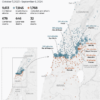
Men work boarding up a window as Tropical Storm Francine intensifies and is on track to become a hurricane before its expected landfall on the U.S. Gulf Coast, in Morgan City, Louisiana, U.S. September 10, 2024.
Marco Bello | Reuters
Hurricane Francine made landfall Wednesday in Louisiana as a Category 2 storm, bringing powerful winds, deadly storm surge and potential flooding on the northern U.S. Gulf Coast.
Francine drew fuel from exceedingly warm Gulf of Mexico waters. The cyclone had maximum sustained winds of 100 mph (161 kph) when it roared ashore in Terrebonne Parish, the Miami-based National Hurricane Center said.
Parts of Mississippi, Alabama and the Florida Panhandle were at risk of flooding starting Wednesday. The lower Mississippi Valley and lower Tennessee Valley could see flooding later in the week as the soggy remnants of Francine sweep inland.
Francine aimed at a Louisiana coastline that has yet to fully recover from a series of devastating hurricanes in 2020 and 2021.
Francine drew fuel from exceedingly warm Gulf of Mexico waters, strengthening from a Category 1 to a Category 2 storm, with winds of 96 to 110 mph (155 to 175 kph), the National Hurricane Center.
“I know that we have been through a lot here in Louisiana, but I urge everyone to take the necessary preparations,” said Louisiana Gov. Jeff Landry, who urged residents to “stay off the roads, stay home and stay put.”
Hurricane season typically peaks around this time of year and Louisiana residents have often faced threats from such storms. Since the mid-19th century 57 hurricanes have tracked over or made landfall in Louisiana, according to The Weather Channel. Among them are some of the strongest, costliest and deadliest storms in U.S. history.
Satellite image of Hurricane Francine on Sept. 11th, 2024.
NOAA GOES EAST
Landry said the Louisiana National Guard was being sent to parishes that could be impacted by Francine. They have with food, water, nearly 400 high-water vehicles, about 100 boats and 50 helicopters to respond to the storm, including possible search-and-rescue operations.
Francine was centered Wednesday evening about 65 miles (105 kilometers) southwest of Morgan City and was moving northeast at 17 mph (27 kph) with maximum sustained winds of 100 mph (155 kph), the Miami-based hurricane center said.
Morgan City, home to around 11,500 people, sits on the banks of the Atchafalaya River in south Louisiana and is surrounded by lakes and marsh. It’s described on the city’s website as “gateway to the Gulf of Mexico for the shrimping and oilfield industries.”
Larry Doiron, the owner of a Chevron station just outside of Morgan City limits, said he had enough gas to keep pumps operational through the storm.
“We’re the only place out here for the sheriff’s department, the fire department. We have gas. All the locals depend on us,” he said. “We’re going to try and stay on top of it and hopefully take care of everybody.
President Joe Biden granted an emergency declaration that will help Louisiana secure federal money and logistical assistance from partners such as the Federal Emergency Management Agency. Both Landry and Mississippi Gov. Tate Reeves also declared states of emergency, authorizing them to quickly free up resources for disaster assistance.
A hurricane warning was in effect along the Louisiana coast from Cameron east to Grand Isle, about 50 miles (80 kilometers) south of New Orleans, according to the center. A storm surge warning stretched from the Mississippi-Alabama border to the Alabama-Florida border. Such a warning means life-threatening flooding could occur.
The Mississippi Emergency Management Agency said it distributed more than 100,000 sandbags to the southern part of the state and the Department of Education reported a number of school district closures for Wednesday and Thursday.
Bands of heavy rain were hitting New Orleans Wednesday morning. The city’s historic streetcars that roll on South Carrollton Avenue had to ease past cars that motorists parked next to the tracks on the grassy median. The median is a few inches higher than the street and drivers sometimes park there to avoid street flooding.
Francine is the sixth named storm of the Atlantic hurricane season. Much of Louisiana and Mississippi could get 4 to 8 inches (10 to 20 centimeters) of rain, with the possibility of 12 inches (30 centimeters) in some spots, Brad Reinhart, a senior hurricane specialist at the hurricane center.
The hurricane center said parts of Mississippi, Alabama and the Florida Panhandle were at risk of “considerable” flash and urban flooding starting Wednesday. The lower Mississippi Valley and lower Tennessee Valley could experience flooding later in the week as the soggy remnants of Francine sweep inland.
Francine’s storm surge on the Louisiana coast could reach as much as 10 feet (3 meters) from Cameron to Port Fourchon and into Vermilion Bay, forecasters said.
EMEA Tribune is not involved in this news article, it is taken from our partners and or from the News Agencies. Copyright and Credit go to the News Agencies, email news@emeatribune.com Follow our WhatsApp verified Channel





